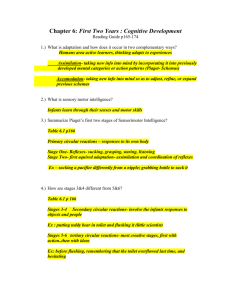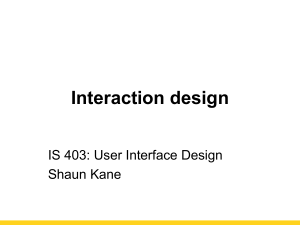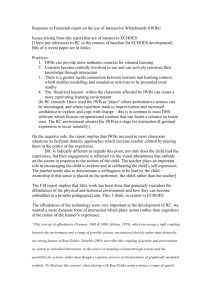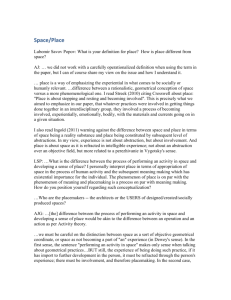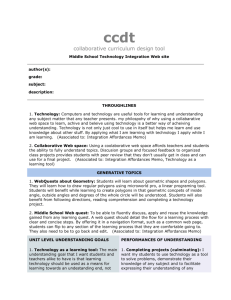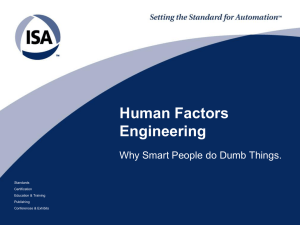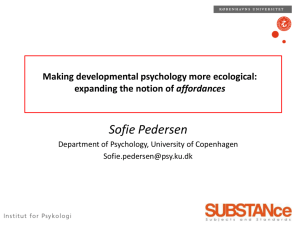DSMEaffordJBGS5Nov04 - Extranet
advertisement
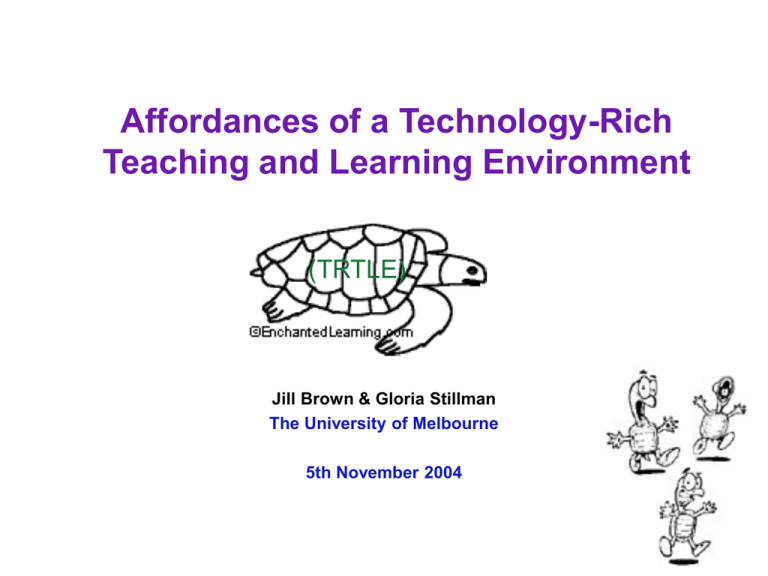
Affordances of a Technology-Rich Teaching and Learning Environment (TRTLE) Jill Brown & Gloria Stillman The University of Melbourne 5th November 2004 RITEMATHS Project Australian Research Council (ARC) Linkage Project 2004-2006 Enhancing Mathematics Achievement and Engagement by Using Technology to support Real Problem Solving and lessons of High Cognitive Demand Research Team • Chief Investigators – Prof Kaye Stacey – Dr Gloria Stillman – Dr Robyn Pierce (University of Ballarat) • Australian Postgraduate Award (Industry) – Jill Brown • Ballarat Project Officer – Sandra Herbert (University of Ballarat) • Melbourne Project Officer – Peter Fox Industry Partners • Secondary School Partners – Ballarat SC – Canterbury Girls SC – Luther College – Mt Clear SC – Santa Maria College – Westbourne Grammar • Texas Instruments Aim of Project To discover the most effective ways to use technology to stimulate higher order thinking in mathematics classrooms, in the context of using real world problems. Technologies Real-world interfaces bring a virtual world into the classroom for analysis: image digitisers, software enabling analysis of video, dynamic control of simulations, and data loggers. Mathematics analysis tools are tools that do the computational work (symbolic, graphical, numerical): graphing calculators spreadsheets, [GC], Geometer’s (including APPS on GC) Computer SketchPad Algebra [GSP], Systems specific [CAS], applications Research Themes Context Theme: Dr Gloria Stillman Algebra Theme: Dr Robyn Pierce & Sandra Herbert Affordances Theme: Prof Kaye Stacey & Jill Brown Context Theme Aim: To discover how teachers can engineer the learning environment to manage the added cognitive complexity of applying mathematics to model and resolve real world problems. Algebra Theme: Research questions How can technology be used to: • help students gain symbol sense, algebraic insight, algebra expectation? • increase students’ ability to work with symbols to solve problems? • help students tackle ‘bigger’ and ‘harder’ problems? • change the way students think about using algebra to solve problems? • Dr Caroline Bardini and Dr Robyn Pierce presented preliminary findings for the Algebra theme in a previous DSME seminar . Affordances Theme Aim: To explore the ways in which the affordances of a Technology-Rich Teaching and Learning Environment can assist students to use their insights from real world situations to support abstract thinking. (TRTLE) The Learning Sciences A fundamental assumption of many learning scientists is that cognition is not a thing located within the individual thinker but is a process that is distributed across the knower, (TRTLE) the environment in which knowing occurs, and the activity in which the learner participates. In other words, learning, cognition, knowing, and context are irreducibly co-constituted and cannot be treated as isolated entities or processes. (Barab & Squire, 2004, p. 1) Design Study: What is happening? Purpose of preliminary data collection • to gain greater insight into the thinking of the students in project classrooms • what it is the teachers of these classes want their students to learn when introducing linear functions • to provide a substrate for theorising and testing conceptual frameworks. Data Collection to Date Project Teacher interviews Classroom observation Teacher and researcher reflections Hidden Function Task (5 classes) & Barbie Bungee (2 classes) • Student Record Sheets • Post-task Interviews (Students and Teachers) • Video & audio recording of focus pairs solving the task in the classroom • Recording of graphing calculator screens during task solution (HF only) Research Questions RQ1: What is it about the TRTLE that allows teachers to perceive particular affordances for teaching and learning and act on these to improve student understanding of functions and the development of higher order thinking? RQ2: What is it about the TRTLE that allows students to perceive particular affordances for learning and act on these to maximise their understandings of functions and engage in higher order thinking? What are Affordances? “When the constant properties of constant objects are perceived … the observer can go on to detect their affordances. I have coined this word as a substitute for values … . I mean simply what things furnish for good or ill” (Gibson, J. J., 1966, p. 285). “The verb to afford is found in the dictionary, but the noun affordance is not. I made it up. It implies the complementarity of the animal and the environment” (1979, p. 127) Gibson’s Affordances Relationships between objects and actors involved in interactive activity. – Offerings or action possibilities in the environment in relation to the action capabilities of an actor – Independent of actor’s experience, knowledge, culture or ability to perceive – An affordance exists or it does not – Affordances don’t change as an observer’s needs change – They can be promises or threats Gibson’s Motivation •To understand what motivates human behaviour •Before one can act, action must be perceived as possible •The perception of an affordance motivates the doing of an action •Affordances define allowable actions Need for Research into Affordances “Research examining the concept of affordances is crucial if we are to build … a more flexible design orientation to the practices of education” (Pea, 1993, p. 52). “Affordances describe how the interaction between perceiver and perceived works - and that is exactly what we need to understand in educational research” (Laurillard, Stratfold, Luckin, Plowman, & Taylor, 2000, p. 3). Affordances of a TRTLE Affordances of a TRTLE - are the offerings of such an environment for both facilitating and impeding learning - are potential relationships between the teacher and/ or student and the environment - involve interactive activity between the human and the environment Affordances of a TRTLE To take advantage of the opportunities arising, affordances need to be perceived and acted on by both teachers and students. This action may well include the rejection of a particular affordance in favour of another affordance. What Specifies an Affordance To perceive an affordance a person has to become attuned to the invariant or disturbance specifying it. An invariant is a property of something in the environment relative to some source of change (eg, a moving point of observation) which leaves it unchanged in a way that is typical of the thing specified. Invariants are what remains despite a transformation. A disturbance is a property of something in the environment relative to some source of change (eg, an approaching predator) such that a pattern of change is presented that is typical of the thing specified. Learning in a TRTLE Learning in a TRTLE happens through becoming attuned to the invariants and disturbances which specify the affordances. Example 1: Invariants and Cubic Functions - what specifies a cubic function? Example 2: Disturbances and Cubic Functions A person becomes attuned to affordances through greater noticing of critical differences and less noticing of irrelevancies. Affordances as Disturbances Affordances and Affordance Bearers It is essential to distinguish between affordances and affordance-bearers. The manifestation of an affordance involves, an event in which both the affordance bearer and the organism are involved. (Scarantino, 2003) In a TRTLE the affordance bearer is, broadly speaking, the technology, more specifically some feature of the technology. The affordance is the interactivity between the user and the technology for some specific purpose. Salient and Enacted Affordances Drijvers points out that for affordances present in a TRTLE to be realised in the classroom depends not only on the existence of the affordances “but [also] on the exploitation of these affordances embedded in the educational context and managed by the teacher” (p. 78). Doerr & Zangor, (2000), also note the importance of teachers being aware of the affordances of a technological environment. Affordances need to be both perceived and enacted or thoughtfully rejected in favour of another affordance. Affordances, NUD*IST, and Inspiration My Emergent Framework NUD*IST and Inspiration! • Analysis tools – Non-numerical Unstructured Data*Indexing Searching and Theorising (NUD*IST) – Inspiration The Affordance Framework • What I have done allows me to characterise what I am seeing. • I also need to find some explanation for non-perception – May emerge from the data – May be able to apply some theory of mispercerption – May use Scarantino’s constructs of doing versus happening affordances (The former involve intention while the latter do not). Truly and Falsely Ascribed Affordances • A falsely ascribed affordance is what Gibson refers to as the misperceiving of an affordance. • Two examples both using the Scale Marks as the affordance bearer – Two students carefully edit the scale marks to facilitate their by-hand sketch of a function – Two students when confronted with an unexpected view of a function on several consecutive occasions edit the scale marks in the apparent belief that this will change their view of the function. It does not. Thanks jillb@unimelb.edu.au
